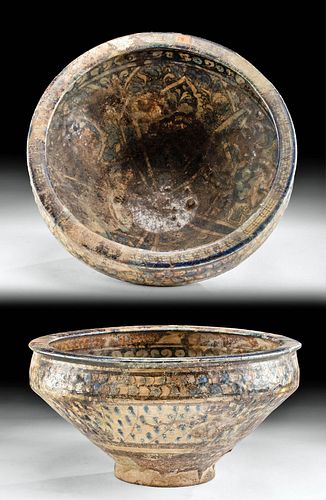14th C. Il-Khanid Sultanabad Ware Bowl, Ex-Museum
Lot 59c
About Seller
Artemis Gallery
686 S Taylor Ave, Ste 106
Louisville, CO 80027
United States
Selling antiquities, ancient and ethnographic art online since 1993, Artemis Gallery specializes in Classical Antiquities (Egyptian, Greek, Roman, Near Eastern), Asian, Pre-Columbian, African / Tribal / Oceanographic art. Our extensive inventory includes pottery, stone, metal, wood, glass and textil...Read more
Categories
Estimate:
$1,500 - $2,250
Absentee vs Live bid
Two ways to bid:
- Leave a max absentee bid and the platform will bid on your behalf up to your maximum bid during the live auction.
- Bid live during the auction and your bids will be submitted real-time to the auctioneer.
Bid Increments
| Price | Bid Increment |
|---|---|
| $0 | $25 |
| $300 | $50 |
| $1,000 | $100 |
| $2,000 | $250 |
| $5,000 | $500 |
| $10,000 | $1,000 |
| $20,000 | $2,500 |
| $50,000 | $5,000 |
| $100,000 | $10,000 |
| $200,000 | $20,000 |
About Auction
By Artemis Gallery
Mar 4, 2021
Set Reminder
2021-03-04 10:00:00
2021-03-04 10:00:00
America/New_York
Bidsquare
Bidsquare : Ancient | Ethnographic Art Through The Ages
https://www.bidsquare.com/auctions/artemis-gallery/ancient-ethnographic-art-through-the-ages-6467
Ancient art from Egypt, Greece, Italy and the Near East, as well as Asian, Fossils, Pre-Columbian, Native American, African / Tribal / Oceanic, Fine art, and much more! All categories, all price ranges... all legally acquired and guaranteed to be as described or your money back. Artemis Gallery info@artemisgallery.com
Ancient art from Egypt, Greece, Italy and the Near East, as well as Asian, Fossils, Pre-Columbian, Native American, African / Tribal / Oceanic, Fine art, and much more! All categories, all price ranges... all legally acquired and guaranteed to be as described or your money back. Artemis Gallery info@artemisgallery.com
- Lot Description
Near East, Iran, Sultanabad, ca. 14th century CE. A stunning ceramic bowl boasting a gorgeously glazed surface of ultramarine and sky blue motifs on a creamy white ground. Supported by a discoid foot, the ornate vessel features impressively thin walls that slope dramatically outwards then slightly inwards and a wide, flared rim that hangs over a deep basin. The interior of the vessel is adorned with an elaborate floral program of a central narrow-petalled flower surrounded by abstract, vegetal designs and a border of alternating spirals and target motifs. Alternatively, the exterior is embellished with two registers of a fish scale pattern near the rim and a polka-dotted body. Three black bands beneath Arabic script decorate the rim of this fabulous dish. Size: 11.5" in diameter x 6" H (29.2 cm x 15.2 cm)
Islamic art flourished under the reign of Il-Khan Mahmud Ghazan (r. 1295–1304). The Persian-Islamic aesthetic also adopted East Asian influences to create a new artistic vocabulary that was admired by many cultures from Anatolia to India. In addition, pottery, jewelry, metalwork, textiles, and illuminated manuscripts evolved greatly along already established lines during the Il-Khanid period.
According to the Brooklyn Museum of Art, "Shared motifs and designs in the art of diverse cultures along the Silk Route provide some of the most visible evidence of cultural transmission between China and the Islamic world. Through trade, tribute, gift exchange, and the spread of religions such as Buddhism, Manichaeism, Judaism, Christianity, and Islam, imagery associated with one artistic tradition was often adapted or incorporated in another cultural context. Motifs that appear across the arts of China, Central Asia, and the Islamic world include fantastical animals such as dragons and phoenixes; cloud bands and cloud collar motifs; and flowers such as lotuses and peonies. Yet the meanings linked to these motifs often did not transfer from one context to the next. Similar imagery could exist simultaneously in several regions while signifying different things. In the twelfth and thirteenth centuries, Iranian potters developed a stone paste body also known as fritware, intended to imitate the smooth white surface of Chinese porcelain." Thus, the flower that decorates the center of this vessel likely represents a Mongol Ilkhanid interpretation of the Chinese lotus, which was unknown in Iran.
Provenance: ex-private New Jersey, USA collection; ex-Baltimore Museum of Art, BMA #1951, 162, Baltimore, Maryland, USA; ex-collection of Mrs. Louis Azrael, Maryland, USA
All items legal to buy/sell under U.S. Statute covering cultural patrimony Code 2600, CHAPTER 14, and are guaranteed to be as described or your money back.
A Certificate of Authenticity will accompany all winning bids.
We ship worldwide and handle all shipping in-house for your convenience.
#161955Collection label on rim, another on lower wall near foot, and several more on base. Repair from three pieces on one side with break lines barely visible. Otherwise, excellent with lovely earthen deposits, beautiful iridescence to interior, and great craquelure on glazed areas.Condition
- Shipping Info
-
All shipping is handled in-house for your convenience. Your invoice from Artemis Gallery will include shipping calculation instructions. If in doubt, please inquire BEFORE bidding for estimated shipping costs for individual items.
-
- Buyer's Premium



 EUR
EUR CAD
CAD AUD
AUD GBP
GBP MXN
MXN HKD
HKD CNY
CNY MYR
MYR SEK
SEK SGD
SGD CHF
CHF THB
THB

















